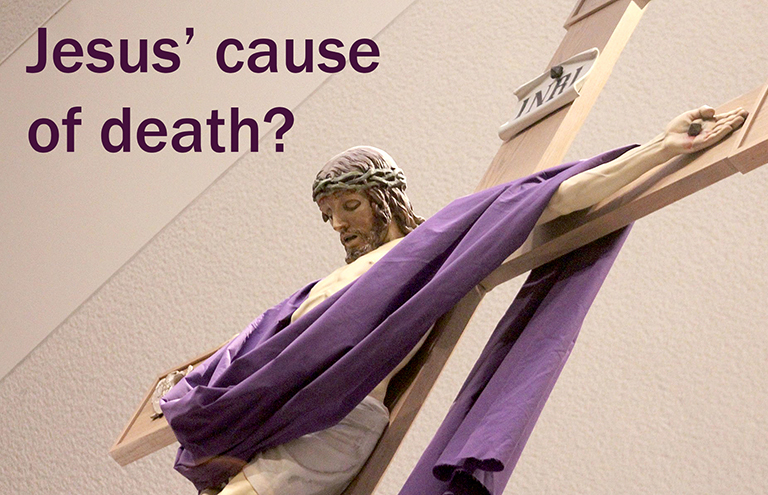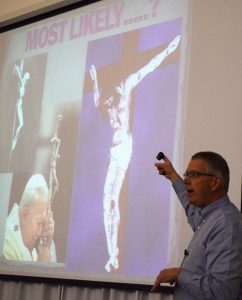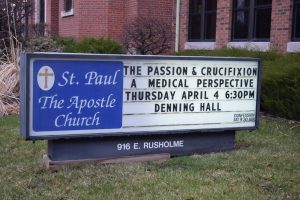Quad Cities Catholic physician believes Jesus died from excessive blood loss

Jesus is depicted on the cross in this crucifix from St. Thomas the Apostle Church in Peoria Heights, Illinois. Dr. Timothy Millea, an orthopedic surgeon from Bettendorf, Iowa, believes that Jesus likely died from an excessive loss of blood. (The Catholic Post file/Jennifer Willems)
DAVENPORT, Iowa — Jesus likely died from excessive blood loss, a local Catholic physician said April 4 during a talk that examined the 18 hours of Christ’s passion and crucifixion from a medical perspective.
“Christ emptied himself,” said Dr. Timothy Millea, an orthopedic surgeon who is president of the local guild of the Catholic Medical Association.

Dr. Timothy Millea, an orthopedic surgeon from Bettendorf, Iowa, is pictured giving a presentation titled “The Passion and Crucifixion: A Medical Perspective” on April 4 at St. Paul the Apostle Church in Davenport. (The Catholic Post/Tom Dermody)
“As a surgeon, two words that make our hair stand on end are ‘bleeding out,’” he told about 100 people who gathered in Denning Hall of his home parish of St. Paul the Apostle in Davenport as Holy Week neared. “If you can’t stop it, you can’t keep that patient alive.”
An adult male has about 1.5 gallons of blood, said Millea. The loss of 40 percent can lead to hypovolemic shock, a life-threatening condition. Jesus likely surpassed that threshold after repeated beatings through the night, an intense scourging at the hands of Roman soldiers that included wearing a crown of thorns, and nails driven through his upper wrists and feet.
“Some people ask, did Jesus really die of physical factors, or did he — as God — say, ‘OK, my work is done,’” said Millea, who has offices in Bettendorf and Moline. After taking his audience hour-by-hour through Jesus’ physical and emotional suffering from the agony in the garden to his death on the cross, Millea countered that “how he lived this long is one of the biggest divine mysteries.”
“WE’LL GET THROUGH THIS”
Millea said his interest in the medical and scientific aspects of what he called “the most important event in the history of mankind” began in 1986 when, as a fourth-year medical student living in Alabama, he read an article titled “On the Physical Death of Jesus Christ” in the Journal of the American Medical Association. His subsequent research showed that Jesus’ medical condition has been discussed since the 16th century.
Among the latest sources he quoted was the 2014 book “A Doctor at Calvary: The Passion of Our Lord Jesus Christ” by Dr. Pierre Barbet. Millea also referenced modern research on the Shroud of Turin, believed by many to be Jesus’ burial cloth.
For example, he said the man whose image is seen on the shroud is 5 feet 10 inches tall and weighed about 175 pounds. While tradition says Jesus was whipped 39 times in his scourging, nearly 400 wound marks are counted on the shroud and “every one of them (was) bleeding.”
While Millea promised his talk would not be “like watching Mel Gibson’s movie again” — a reference to the graphic depictions of Jesus’ sufferings in the 2004 biblical drama “The Passion of the Christ” — there came a time in his description of the crucifixion when he paused and asked his audience to “bear with me, we’re going to get through this. I don’t like this part, either, but it’s pretty important.”
TRAGIC, HORRIBLE, BUT SAVING
Millea described Jesus’ passion and death as “a tragic story, a horrible story, a painful story,” but ended his presentation by showing an image of the resurrected Christ on the screen to illustrate that “this story doesn’t end with where we finish tonight.”

Dr. Millea notes that how Jesus likely appeared on the cross is replicated on the pastoral staff that St. John Paul II used while pope. (The Catholic Post/Tom Dermody)
In fact, his talk had nearly as much theological and spiritual content as scientific and medical. It contained frequent references to Scripture, including Old Testament passages that foretold Christ’s suffering and death.
Millea acknowledged that other physicians and historians have suggested that Jesus might have died from asphyxiation because the work of breathing was so difficult on the cross. Others say perhaps he had a heart attack after the hours of physical exertion and trauma.
But Millea feels the blood loss theory is not only medically likely, but corresponds well with the theological teachings of atoning sacrifice, with Jesus taking the place of the slaughtered lambs of the Old Testament. Sacrificed animals also died from blood loss.
“Jesus was literally the sacrificial lamb,” said Dr. Millea. “That’s what he had to do. And that is about as much in the way of love and charity as you can imagine.”
MEDICAL, HISTORICAL EVIDENCE
Among the medical and historical evidence Dr. Millea cited included:
- There is a rare medical condition that matches the description in the Gospel of Luke that Jesus’ sweat during his agony in the Garden of Gethsemane “became like drops of blood.” The condition, called hematohidrosis, causes blood to be released through the skin and “is almost always associated with intense emotion or physically challenging episodes.”
- The weapon used in the scourging was likely a flagrum, leather cords 2 feet long that containted metal objects, glass, and lead balls. “It was a very diabolically effective means of harming the tissues down to muscle depth,” said Dr. Millea.
- The crown of thorns likely more resembled a helmet than the laurel wreath depicted in art. “Every time the soldiers hit the thorns, they impaled in his scalp,” said Dr. Millea. “If you’ve ever had a cut on your scalp, you know it bleeds like crazy.”
- Jesus probably carried “only” the horizontal beam of the cross, because both beams would have weighed 300 pounds. “You’ve got a 175-pound man who has been beaten, he’s bleeding, he hasn’t eaten or slept or had anything to drink, and he’s going to carry 100 pounds for 600 yards. He fell three times? It’s a miracle he didn’t fall more often.”
- The nails in Jesus’ hands likely would not have been in the palms, which could not have held his weight. There is a space in the upper wrist where ligaments are strong. “The problem, for those of you who have had carpal tunnel problems, is that the median nerve travels through there,” said Dr. Millea, meaning the pain would have been intense.
 Dr. Millea went through Jesus’ last seven recorded phrases — including “I thirst” and “It is finished” — which he said were necessarily short because of the difficulty in breathing that Jesus was experiencing. “We’re not going to get a sermon,” said Dr. Millea.
Dr. Millea went through Jesus’ last seven recorded phrases — including “I thirst” and “It is finished” — which he said were necessarily short because of the difficulty in breathing that Jesus was experiencing. “We’re not going to get a sermon,” said Dr. Millea.
Noting the crucifixion was a public spectacle and that there “was no greater humiliation,” Jesus’ followers certainly thought, “This is the worst thing that could ever happen,” not knowing that Christ’s loving sacrifice would later prove to “be the best thing that ever happened.”
Dr. Millea invited the public to future talks sponsored by the St. Thomas Aquinas Guild of the Quad Cities, which he said ranks among the 10 largest guilds of the Catholic Medical Association.





